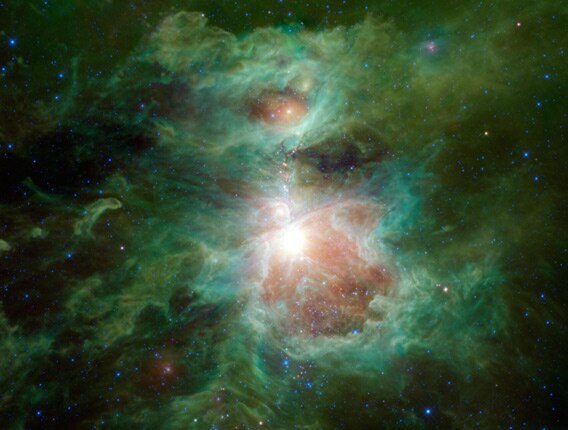Create a free profile to get unlimited access to exclusive videos, sweepstakes, and more!
The Cold Fire of Orion

The Orion Nebula (also called M42) is one of the most recognizable objects in the entire sky. The middle âstarâ in Orionâs dagger hanging below his belt, this cloud of gas and dust is so bright that even from more than 13 quadrillion kilometers (8 thousand trillion miles) away itâs easily visible to the naked eye.
Itâs a vast sprawling complex of interstellar material, lit by the fierce energy of stars born within. Itâs amazing through a small telescope, stunning through a big one, and gorgeous in picturesâ¦but then adjectives seem a little dingy and small when trying to describe the view in the infrared:
Jaw-dropping? Mind-blowing? I canât come up with a hyphen-dashing word appropriate for this. Itâs chillingly beautiful.
And I do mean chilling. This is the view from NASAâs Wide-field Infrared Survey Explorer (WISE), one of my all-time favorite space astronomy missions. It scanned the sky continuously, able to see objects in one go that most telescopes would need huge mosaics to encompass completely. Its detectors were designed to see in the infrared, where extremely cold objects emit light.
In this false-color picture, blue is actually light at a wavelength of 3.4 microns (about five times longer than you can see with your eye, and mostly coming from stars), green is 12 microns, and red is 22 microns. The coolest material you see is dust, complex organic molecules called PAHS, for polycyclic aromatic hydrocarbonsâpretty much just soot. Dust is created in the atmospheres of stars when they are born and when they die, and itâs common in giant clouds where stars are being born.
The Orion Nebula (and the Flame Nebula, located just above M42 in the WISE shot) is the closest big stellar nursery. Amazingly, the visible part of the nebula is just one small part of it! The entire complex is whatâs called a giant molecular cloud, a fog of gas and dust that is so thick itâs completely opaque and invisible to the eye. Itâs outline becomes more apparent in the infrared, and you can start to get a sense of the three-dimensional structure.
The nebula itself is actually caused by several extremely massive stars that have formed near the edge of the cloud. Once the stars formed, their fierce heat and strong winds herniated the cloud, blowing out a cavity in the cloudâs side, letting their light out. The glow in pictures is due to both thin gas fluorescing like a neon sign as well as the dust itself lit directly by the stars.
When I picture it in my head, I actually visualize it like the Death Star, if it were cloaked and all you could see was the dish from the planet-killing main weapon. But then, Iâm a dork.
Still, the incredible beauty of this region is undeniable. I was looking at it through my own small telescope just the other day, the wisps of gas visible, as well as the four stars of the Trapezium, the incredibly massive and hot stars illuminating essentially that whole region. The gorgeous and delicate view was amazing, and only heightened by my knowledge that nearly every single star I could see would someday explode as a tremendous supernova, releasing energies so vast and terrible our puny minds canât grasp them except as numbers and physical equations.
Someday, perhaps in a million years, perhaps less, this incredible region will undergo a sudden and extraordinarily violent change. It will still be beautiful, but in a different way, I suppose. And what a boon it will be to science, to see supernovae from only 1300 light years away! They will shine as brightly as the Moon, casting shadows on the ground for weeks as they flare and finally dim. What a sight that will be!
There is beauty in pictures like this, but there is also such beauty in knowledge. Knowing is always better, and always adds depth and meaning to art, especially the scientific kind.


























